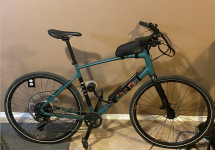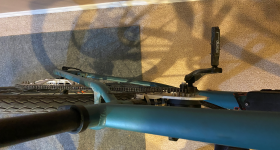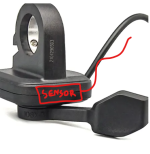Howdy,
After watching some videos and getting inspired to go a little deeper than a grin ready to roll kit, I thought I'd post my results of a mid-drive here to share. I love my front hub but I wanted to try something with better weight distribution, and less overall weight. I really like regular biking, especially the drive trains, so this was my approach to a mid-drive while keeping my regular drive train intact. I was not trying to make a motorcycle, just a decent moped.
I would like to specifically thank ES users @thepronghorn, @FZBob, @district9prawn, and @mxlemming. Their build posts showed me it was very possible to build what I wanted. I would also like to thank anyone who has posted anything, it's all good knowledge.
Motor: Flipsky 7070 110Kv (comes out at 118Kv from the baserunner autotune). From Amazon
Controller: Baserunner L10 V3. From GRIN
Controller controller: Cycle Analyst V3 running 3.14 firmware. From GRIN
Battery: 48V 16.5Ah. From GRIN
One regular throttle 0-5V. From Amazon
One Ebrake sensor. From EM3EV
1/8'' 6061 Aluminum Custom sprocket*. From local metal cut/bend shop
1/8'' and 1/4'' 6061 Aluminum Custom motor mount*. From local metal cut/bend shop. Slotted holes for chain tensioning.
Several 10T-20T motor sprockets. From Amazon.
*Had to learn CAD and used FreeCad. FreeCad gets the job done, it's probably good for learning but I'm not the one to say. It struggles with some complex designs and you need to be really careful with your order of operations or it nukes your PC, or it nukes your model due to an internal bug. Considering it's free, its amazing.

Motor mount has three pieces. One 1/4'' thick plate with slotted holes for chain tensioning. 44mm dia bolt array for motor mount and a slot for a 10mm shaft. Then there is a 1/8''' piece to space that plate out from the seat tube, taken from the same model but with most of it shaved off as it's just a spacer. Last piece connects to the bottle bosses and has some stick out parts to help align the other two plates. The whole mount is attached with 4 hose clamps.
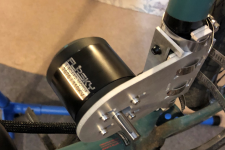
The sprocket is all 1/8'' thick plates, I had two designs, one with bent spokes that actually managed to work and one with flat spokes and spacers to push it out form the chain/seat stays. All held together with M5 hardware and nylocks. It attaches to the hub using the 6 hole disc rotor pattern. My current design requires that I sacrifice my rear disc caliper. In hindsight it is definitely possible to re-design my bent spokes to allow for regular disc caliper and rotor use. Design is for a #25 chain for maximizing teeth count for reduction purposes.
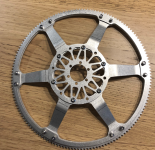

So far it's running at 60%. I give it 60% because it moves, but won't be relied on for what it is.
First issue is I can't for the life of me get my hands on a #25 or #25H chain built to ANSI specs in a length longer than 16''. I have been through 4 10ft chains that are short in pitch by what seems to be just under 0.1 mm (crap calipers), and they end up not seating after 50-60 teeth of engagement, before seating again 20-30 teeth later. I have had a few 16'' timing chains (advertised as 10ft...) that measured perfect and fit perfect(or at least consistently with with craplipers). I compared the two types and the good 16'' chains were about 1 mm longer than their crap counterparts for the same number of links. I have another 10ft length on order from a hobby robots supplier in Canada so hopefully that will work better than the china chains I have used so far. Worst case I will link up way too many little timing chains (at least they come in #25H). Fixing this should put me at a conditional 100%.
Second issue is I can't get the baserunner consistently tuned. If I run autotune over and over I keep getting completely different hall configurations. Running sensorless fixes that issue but id like to have a bit of power from standstill without the sensorless jerk. Some of the detected hall sensor configs work for a period before I get an overcurrent fault, but overall the start is not that much different from sensorless. I plan on playing hall sensor bingo in the near future to see if that remedies my issues with the baserunner recognizing them. Regen seems to work on the bike stand but I have not used it under load.
When in use I have been limited to using a 20T motor sprocket to maximize engagement at one end (not a good gear reduction), and I have disabled regen so the chain only slips one way. It works but its way too spicy for anything outside of the back alley for testing, and I'd rather not trash my sprocket.
Anyone know of a place in Canada that will supply a good #25 or #25H chain without needing to order 500ft of it?
Anyone have any tuning tips for the controller? Or tips on the hall sensors? I think I have read most of the existing posts for base/phase runner tuning, I have had some trouble searching for what I need with hall sensors as the term is used a lot.
Thanks for reading, I will update with more info and photos as I get them.
After watching some videos and getting inspired to go a little deeper than a grin ready to roll kit, I thought I'd post my results of a mid-drive here to share. I love my front hub but I wanted to try something with better weight distribution, and less overall weight. I really like regular biking, especially the drive trains, so this was my approach to a mid-drive while keeping my regular drive train intact. I was not trying to make a motorcycle, just a decent moped.
I would like to specifically thank ES users @thepronghorn, @FZBob, @district9prawn, and @mxlemming. Their build posts showed me it was very possible to build what I wanted. I would also like to thank anyone who has posted anything, it's all good knowledge.
Motor: Flipsky 7070 110Kv (comes out at 118Kv from the baserunner autotune). From Amazon
Controller: Baserunner L10 V3. From GRIN
Controller controller: Cycle Analyst V3 running 3.14 firmware. From GRIN
Battery: 48V 16.5Ah. From GRIN
One regular throttle 0-5V. From Amazon
One Ebrake sensor. From EM3EV
1/8'' 6061 Aluminum Custom sprocket*. From local metal cut/bend shop
1/8'' and 1/4'' 6061 Aluminum Custom motor mount*. From local metal cut/bend shop. Slotted holes for chain tensioning.
Several 10T-20T motor sprockets. From Amazon.
*Had to learn CAD and used FreeCad. FreeCad gets the job done, it's probably good for learning but I'm not the one to say. It struggles with some complex designs and you need to be really careful with your order of operations or it nukes your PC, or it nukes your model due to an internal bug. Considering it's free, its amazing.

Motor mount has three pieces. One 1/4'' thick plate with slotted holes for chain tensioning. 44mm dia bolt array for motor mount and a slot for a 10mm shaft. Then there is a 1/8''' piece to space that plate out from the seat tube, taken from the same model but with most of it shaved off as it's just a spacer. Last piece connects to the bottle bosses and has some stick out parts to help align the other two plates. The whole mount is attached with 4 hose clamps.

The sprocket is all 1/8'' thick plates, I had two designs, one with bent spokes that actually managed to work and one with flat spokes and spacers to push it out form the chain/seat stays. All held together with M5 hardware and nylocks. It attaches to the hub using the 6 hole disc rotor pattern. My current design requires that I sacrifice my rear disc caliper. In hindsight it is definitely possible to re-design my bent spokes to allow for regular disc caliper and rotor use. Design is for a #25 chain for maximizing teeth count for reduction purposes.


So far it's running at 60%. I give it 60% because it moves, but won't be relied on for what it is.
First issue is I can't for the life of me get my hands on a #25 or #25H chain built to ANSI specs in a length longer than 16''. I have been through 4 10ft chains that are short in pitch by what seems to be just under 0.1 mm (crap calipers), and they end up not seating after 50-60 teeth of engagement, before seating again 20-30 teeth later. I have had a few 16'' timing chains (advertised as 10ft...) that measured perfect and fit perfect(or at least consistently with with craplipers). I compared the two types and the good 16'' chains were about 1 mm longer than their crap counterparts for the same number of links. I have another 10ft length on order from a hobby robots supplier in Canada so hopefully that will work better than the china chains I have used so far. Worst case I will link up way too many little timing chains (at least they come in #25H). Fixing this should put me at a conditional 100%.
Second issue is I can't get the baserunner consistently tuned. If I run autotune over and over I keep getting completely different hall configurations. Running sensorless fixes that issue but id like to have a bit of power from standstill without the sensorless jerk. Some of the detected hall sensor configs work for a period before I get an overcurrent fault, but overall the start is not that much different from sensorless. I plan on playing hall sensor bingo in the near future to see if that remedies my issues with the baserunner recognizing them. Regen seems to work on the bike stand but I have not used it under load.
When in use I have been limited to using a 20T motor sprocket to maximize engagement at one end (not a good gear reduction), and I have disabled regen so the chain only slips one way. It works but its way too spicy for anything outside of the back alley for testing, and I'd rather not trash my sprocket.
Anyone know of a place in Canada that will supply a good #25 or #25H chain without needing to order 500ft of it?
Anyone have any tuning tips for the controller? Or tips on the hall sensors? I think I have read most of the existing posts for base/phase runner tuning, I have had some trouble searching for what I need with hall sensors as the term is used a lot.
Thanks for reading, I will update with more info and photos as I get them.


